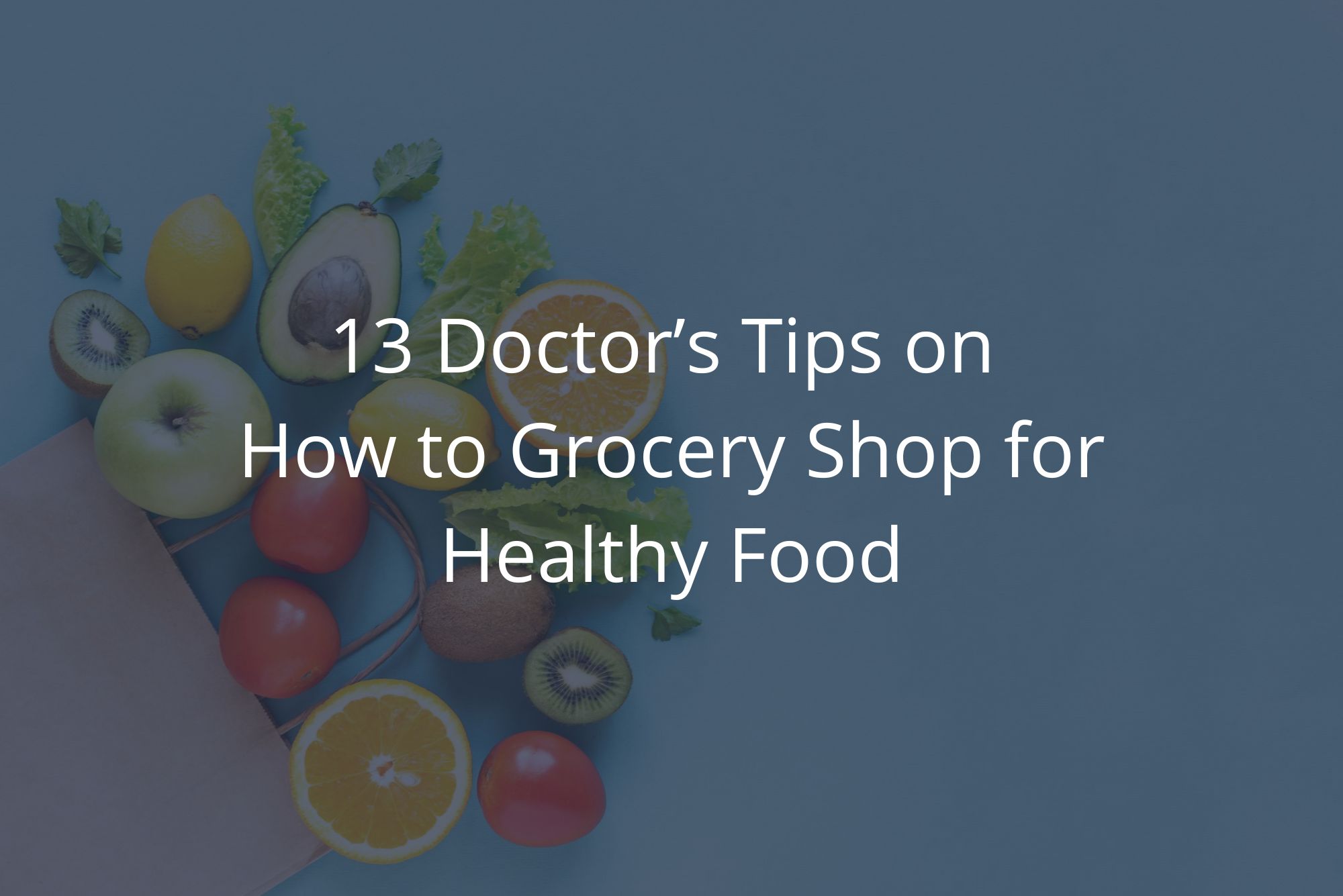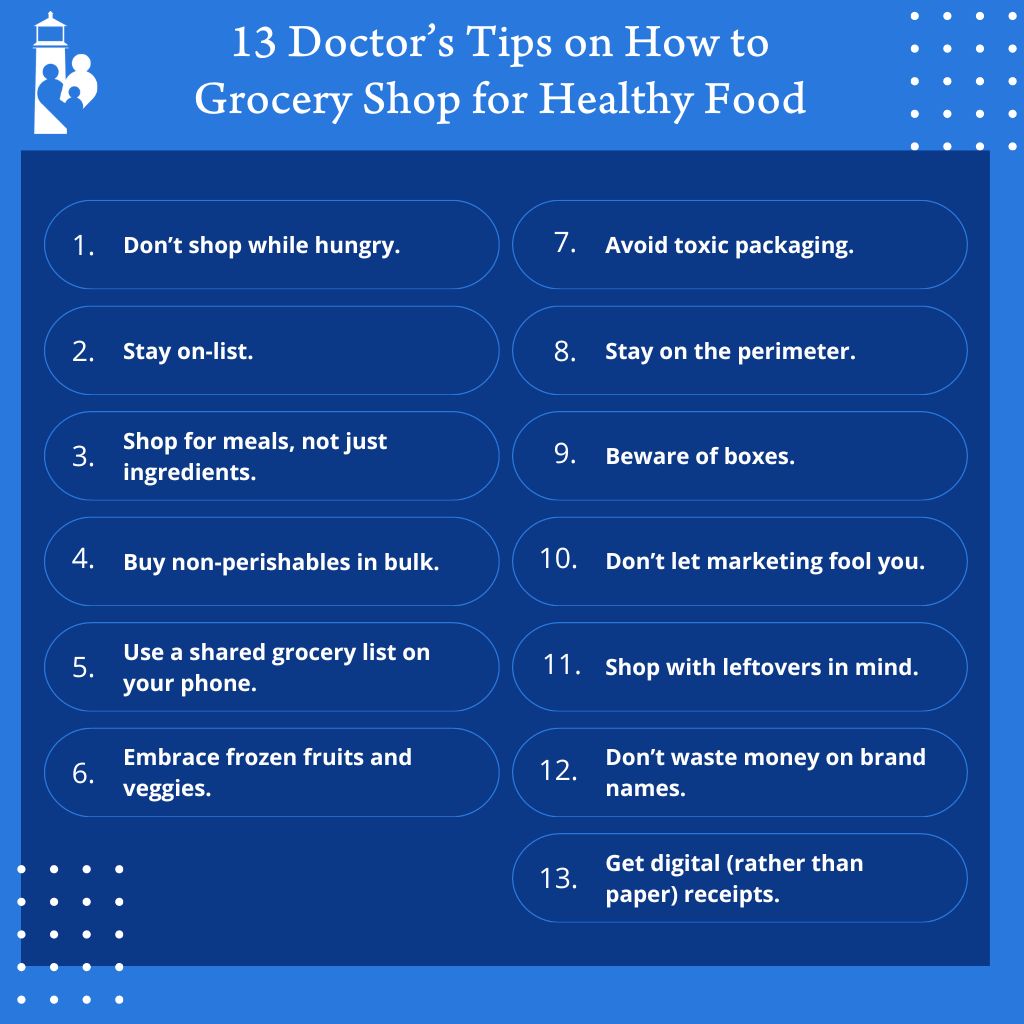
It’s one thing to decide to eat more healthfully, and another thing entirely to succeed at it. Many are the pitfalls of trying to eat healthfully and cleanly in today’s modern world.
The good news is, one of the best ways to ensure you stick to your healthy dietary plans is firmly within your control. It’s how you shop for food.
You can’t eat what you don’t buy. So if you don’t buy junk food at the grocery store, you can’t eat it when your cravings are stronger than your resolve.
Regardless of your budget, the below tips will help set you up for healthy grocery shopping success.
1. Don’t shop while hungry.
Do yourself a gigantic favor and don’t go grocery shopping on an empty stomach. Avoid the supermarket, the farmers’ market, or the big box food section when you’re hungry.
Grocery shopping while hungry means your cravings are front and center. You’ll naturally gravitate toward foods that satisfy those hankerings — and not necessarily what’s healthiest for you.
2. Stay on-list.
Always have a shopping list — and stick to it. Creating a grocery list in advance keeps you and your healthy dietary plan in charge of what you buy. Waiting to make decisions in the store provides too much opportunity for cravings or convincing marketing to make those choices for you.
3. Shop for meals, not just ingredients.
Make that list we just talked about with meals in mind. Shopping with meals in mind makes you more economical, and it also keeps you from buying unhealthy foods simply because they catch your eye.
If an item jumps out at you in the store, ask yourself if it’s a healthy snack or an accompaniment to a meal you’ve already planned. If it isn’t, then leave it on the shelf.
4. Buy non-perishables in bulk.
Buying healthy non-perishables in bulk helps ensure you’re fully stocked on the staples you use most. It’s much easier to maintain a food routine if you always have what you need on hand. If you run out of your go-to healthy options frequently, it becomes difficult to keep up positive habits, and you may default to something less ideal.
If you buy bulk foods that can spoil, such as chicken breasts, repackage them into smaller portions and freeze (if appropriate) to use later.
When you’re buying in bulk, be realistic about what you’ll actually use. You won’t save money on a “more economical” item if half of it ends up in the garbage.
5. Use a shared grocery list on your phone.
If multiple people in your household do the shopping, creating a shared digital grocery list is a game-changer. When one of you uses the last of a healthy item at home, you can add it to the list for whoever goes to the grocery store next. This helps continue the theme of staying stocked with your healthy food items.
List-sharing also avoids multiple trips to the store by multiple people, so it’s more economical and adds a layer of likelihood that you’ll actually get those healthy options into your kitchen.
6. Embrace frozen fruits and veggies.
Don’t actually embrace them in the frozen section; store management might frown on that. But don’t be afraid to incorporate frozen fruits and vegetables into your snacks and meals.
Too often people reject frozen fruits and veggies out of hand. I suggest reconsidering that position. In fact, frozen produce may actually be healthier and more nutrient-rich than fresh produce, which loses its nutrients the longer it sits. Fresh-frozen fruits and veggies retain their nutrients and are often more economical as well.
7. Avoid toxic packaging.
As much as possible, buy foods that are either packaged in glass, or that aren’t packaged at all.
All plastics are unhealthy for people, though some are more unhealthy than others. They contain chemicals like bisphenol A (BPA) and phthalates, which are linked to birth defects, fertility problems, inhibited brain development, and hormone disruption.
Plastic containers obviously contain these chemicals, but so do most cans, which are coated in plastic. Even certain paper products contain phthalates.
When you can’t avoid packaging altogether and glass isn’t available, look for BPA-free and phthalate-free options.
8. Stay on the perimeter.
Sticking to the edge of the grocery store can help you shop healthily and avoid temptation. Most processed foods are up and down the middle aisles. The healthiest foods for you — produce, meats, and fish — are usually in the back and sides of the store.
9. Beware of boxes.
If something comes in a box, it probably has lots of ingredients. And if it has lots of ingredients, it’s probably not good for you.
Boxes are the homes of processed foods. Read the ingredients carefully. If you can’t pronounce it, skip it.
10. Don’t let marketing fool you.
Marketers are clever, and they know what they’re doing when it comes to selling food products. Ignore the claims and adjectives hollering at you from the fronts of packages. Instead, pay attention to things like serving sizes and ingredient lists.
For example, a package may claim, “Only 5 grams of sugar!” But when you look at the serving size, you notice there are four servings per can — so the entire (perhaps tiny) package actually has 20 grams of sugar in it.
Also, remember there’s a big difference between what something is called and what the ingredients are. Consider the actual ingredients and their source, and read beyond the slogans and claims.
11. Shop with leftovers in mind.
About two years ago, I started portioning out dinner leftovers for lunch the next day. It was a small but mighty change.
Having healthy leftovers ready for lunch means you’re never left searching when hunger hits midday. It’s easy, economical, and keeps you on track.
12. Don’t waste money on brand names.
Brand loyalty on certain items can be a non-negotiable (Heinz ketchup forever!). But for many things, it truly doesn’t matter — as long as the ingredients still match your healthy intentions. Switching to the store brand can be more economical, allowing your dollar to go further in areas where higher quality is of greater importance.
13. Get digital (rather than paper) receipts.
Phthalates, like we already mentioned, are hormone disruptors that can damage the liver, kidneys, lungs, and reproductive system.
They’re found in abundance in the commonly used heat-printed receipt paper that nearly all stores use. When you touch that paper, you absorb those chemicals through your skin into your body. So avoid touching receipts as much as possible, and just get digital receipts if you can.
Bottom Line
The payoffs of eating well are worth the trouble it takes to make it happen… but that doesn’t mean it has to be hard. Following these tips can help inject a little more ease into your food-buying routine, putting you — not the store, your cravings, or the marketers — in the dietary driver’s seat.

